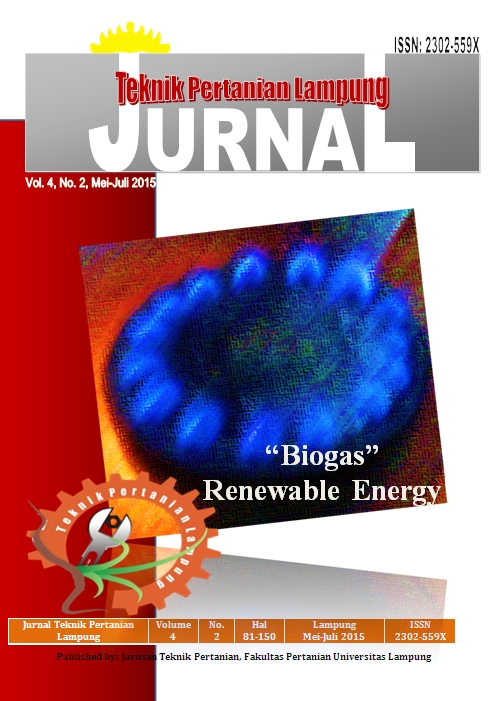RESPONSE OF GROWTH AND YIELD OF TWO VARIETY OF SOYBEAN (Glycine Max . ( L ) Merrill ) TO AVAILABLE SOIL WATER DEPLETION
Abstract
All this time, efforts to improve soybeanproductivity is still based onthe expansion of planting area (Badan PusatStatistik, 2013), but production is still declining. It is also influenced by the lack of understanding about the
cultivation of soybeans and the price is less promising causing farmers are reluctant to plant soybeans. This
research aims to investigate the response of the growth and productionof two varieties of soybean (Glycinemax.
(L) Merrill) to some degree of available soil water depletion. This research was conducted at the Laboratory of
Integrated Courses Faculty of Agriculture, University of Lampung, in May up to August 2014, using factorial
design in a completely randomized designwith the first factor is depletion of groundwater available (P) which is
composed of four levels of available soilwater depletion treatment (ATT) is the treatment P1 (0-20%),P2 (0-40%),
P3 (0-60%), and P4 (0-80%) and the second factor, namely soybean varieties (V), which consists of varieties V1
(Wilis) and V2 (Kaba), with three repetitions. Results were analyzed by F test at LSD further by 5%and 1% by
using Statistix8 Program. The results showed that the effect of the level of available soilwater depletionduring the
vegetative stage and generative phase did not significantly affect plant growth and crop yield. The highest
production yield andWilis varieties Kaba obtained at a rate of 0-40%thinning. Based on these values concluded
that to produce optimal production in both varieties can still bemaintained until the level of depletion of available
soilwater content to 40%.
Keyword : Available SoilWater,Depletions, Generative Phase, Vegetative Phase, Yield.
Downloads
Published
2015-07-25
Issue
Section
Articles
License
- Authors who publish with this journal agree to the following terms:
- Authors retain copyright and grant the journal right of first publication with the work simultaneously licensed under a Creative Commons Attribution-ShareAlike 4.0 International Lice that allows others to share the work with an acknowledgement of the work's authorship and initial publication in this journal.
- Authors are able to enter into separate, additional contractual arrangements for the non-exclusive distribution of the journal's published version of the work (e.g., post it to an institutional repository or publish it in a book), with an acknowledgement of its initial publication in this journal.
- Authors are permitted and encouraged to post their work online (e.g., in institutional repositories or on their website) prior to and during the submission process, as it can lead to productive exchanges, as well as earlier and greater citation of published work (See The Effect of Open Access).
Jurnal Teknik Pertanian Lampung

JTEPL is licensed under a Creative Commons Attribution-ShareAlike 4.0 International License.

